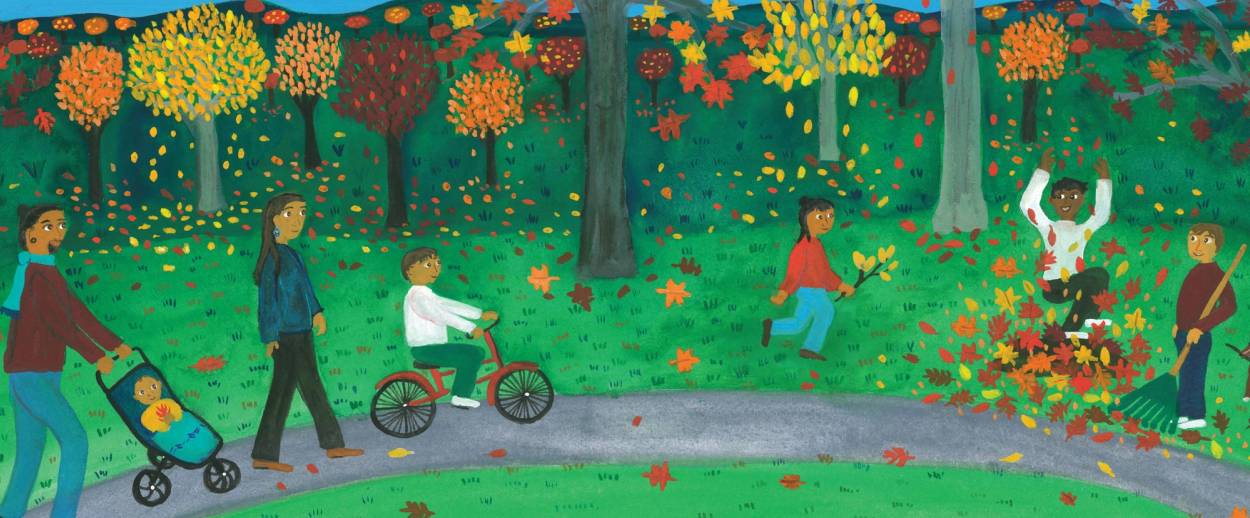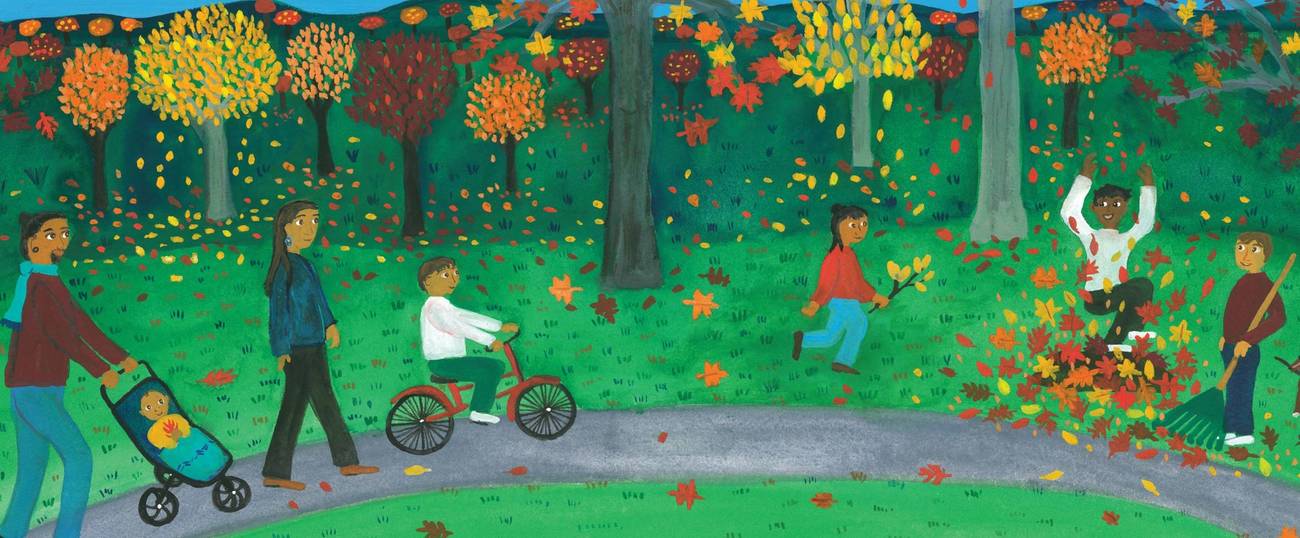A Cross-Cultural Lesson in Gratitude
Children’s books reflect on the importance of thankfulness




Reading a picture book to a child isn’t a monologue; it’s a conversation. The pictures and words on the page (or screen) are just the starting point. From there, you can open a wide-ranging dialogue that uses the book as a jumping-off point to discuss art, values, character, family, collective action … pretty much anything.
Here’s a suggestion for using two terrific picture books—Modeh Ani: A Good Morning Book by Sarah Gershman and We Are Grateful: Otsaliheliga by Traci Sorell—to talk about gratitude, faith, and history.
You probably know Modeh Ani as the morning prayer. Its gist is simple: Thank you for restoring my soul. You say it before you even get out of bed. The simplicity of Modeh Ani is why it’s one of the first prayers Jewish kids learn … but of course, minimalism—when done well—is complex. Just being able to wake up in the morning is mysterious and beautiful. The blessings of existence are big and small, divine and very human.
Modeh Ani: A Good Morning Book, which won a Sydney Taylor Honor in 2011, perfectly captures the mood that makes this prayer feel special. Sarah Gershman’s text is quiet, unflashy, and profound. It’s full of short sentences like these:
Thank you God for waking me from my sleep.
You help me distinguish between day and night.
You give me eyes that open.
May I see the goodness in people.
You created me in your image
and there is no one else quite like me.
I am blessed with people that love me.
May I give love to others and help those in need.
Bits of the actual Hebrew prayer arc, soar, and wind through the pages, in both Hebrew letters and transliteration. Kristina Swarner’s illustrations are luminous, color-saturated, and gentle, full of movement and magic, all cool blues and electric daytime yellows. (Modeh Ani’s companion book, The Bedtime Sh’ma, is equally thoughtful, with a deeper, bluer palette, speckled with starry dots and restful purple washes of color … but when you read it to your child, please change the incorrect “lay” to “lie” and imagine me dying a little inside.) I love that Gershman doesn’t give God a gender, and that she emphasizes doing good as part of being grateful.
The book’s back matter offers excerpts in Hebrew and English from Birkot HaShachar, the morning blessings, and explains Modeh Ani in a bit more detail. Gershman notes that mornings are usually chaotic for families with young children, which is exactly why the morning blessings resonate. “The power of these prayers comes from the juxtaposition of the mundane and the profound, the human and the divine. We give thanks for blessings both small and large, such as the ability to open our eyes and the sunrise—both powerful displays of God’s splendor,” she writes.
It’s instructive to compare and contrast the book with We Are Grateful: Otsaliheliga, which garnered starred reviews from Kirkus, School Library Journal, and The Horn Book, and won the American Library Association’s Sibert Medal for the best informational book for children last year. The first page reads, “Cherokee people say otsaliheliga to express gratitude. It is a reminder to celebrate our blessings and reflect on struggles—daily, throughout the year, and across the seasons.” At the bottom of that page and many others, the Cherokee words are translated, transliterated, and written in the Cherokee alphabet.

We Are Grateful takes us through an extended family’s year. They feel otsaliheliga (oh-JAH-lee-heh-lee-GAH) to unelanvhi (oo-NEH-la-nuh-HEE), literally “the one who provides all,” as the seasons pass. The book opens in autumn, with the Great New Moon Ceremony, when “we clean our houses, wear new clothes, enjoy a feast, and forget old quarrels to welcome the Cherokee New Year.” Winter brings gratitude for “buttery bean bread and steamy hominy soup.” In spring, the family is grateful “for thunder and lightning’s protection of the emerging sprouts.” In summer, the family feels otsaliheliga as “we sink our teeth into the season’s first harvest at the Green Corn Ceremony.”
The book is beautiful in its specificity, while also allowing Jewish parents to draw parallels with our own traditions. Our new year, too, starts in the fall and is tied to the new moon; we, too, wear new clothes, forgive and request forgiveness. (The afterword mentions that at fall’s Great New Moon Ceremony, “people fast, teach, share a community meal, and then stomp dance.” We do all these things at the start of our new year, too, with the exception of the stomp dance. We Jews beat ourselves on the breast instead. Welcome to Judaism.) So many of the ceremonies and rituals named throughout the year—taking care of wildlife, revealing the Cherokee name of a baby, offering a seasonal prayer for rain, remembering the ancestors’ sacrifices—almost literally made me quiver in recognition. Same-same! Yet different!
Frané Lessac’s gouache paintings are richly hued, deliberately folk-arty, full of gorgeous detail. There’s so much for a kid to gaze at on each page: embroidered skirts, feathered hats, decorated pottery, flowering trees. In one image, where the family gathers “to remember an uncle who has passed on,” there are feathers resting against the tombstone; I was reminded of our tradition of leaving stones on a grave—something an adult reader might want to point out to a child. In addition, I appreciated the many different skin tones of the characters … something Jewish books are still working on.
The back matter is unusually deep, offering many teachable moments for parents, grandparents, teachers, and caregivers. Sorell pointedly notes that otsaliheliga remains a core value despite Cherokee people’s ample reasons to feel disengaged and unthankful. She explains The Trail of Tears (when 100,000 Indians from different tribal nations were forced out of their homelands, and many died from walking all day and sleeping outside in brutal heat and icy cold) in simple but potent language. I felt parallels to Jewish history there, too, with Jews as both the removed and the removers. Sorell also discusses the preservation of the Cherokee language; Sequoyah, in 1821, created the Cherokee syllabary, a character-based system that represents syllables that can form phrases, words, or entire sentences. I was reminded of Eliezer Ben-Yehuda’s 1851 creation of the first Hebrew dictionary, the creation of modern Hebrew words, and revival of Hebrew as a living language.
We Are Grateful’s publisher, Charlesbridge, includes even more resources on its website. There are recordings of a Cherokee language speaker pronouncing the words in the book properly, downloadable coloring sheets, and a teacher’s guide.
Both We Are Grateful and Modeh Ani give adults an opening to talk with kids about what blessings are. Sometimes we forget that kids don’t actually know certain common words that we’ve never defined for them and take for granted that they know. Why is it sometimes hard to feel grateful? Why might we want to remember tragic events in our history … and feel grateful despite them? Why is it important to remember ancestors? Furthermore, why do we think otsaliheliga is in first-person plural voice, while Modeh Ani is one of the few Hebrew prayers in the first-person singular?
If you want to go the extra mile, you might also pick up Thank You, Omu (pronounced AH-moo), a tasty book about gratitude for a grandmother who makes a delectable soup that feeds the whole community. The community, thankfully, shows its gratitude right back. Oma is the Igbo word for queen; author-illustrator Oge Mora, who won the Caldecott Honor this past year for this (her very first book! fellow Rhode Islander, I salute you!) is of Nigerian heritage. The art, depicting candy-colored city life in textured acrylic paint, full of blocks and rectangles and patterned-paper collage, is superreminiscent of Ezra Jack Keats’ work. Again, we grown-ups are given a gift: an opportunity to talk cross-culturally about being grateful, about the importance of family and community, and about why we need to be giving and generous people.
Because we do.
***
Like this article? Sign up for our Daily Digest to get Tablet magazine’s new content in your inbox each morning.
Marjorie Ingall is a former columnist for Tablet, the author of Mamaleh Knows Best, and a frequent contributor to the New York Times Book Review.